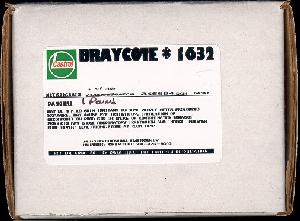Castrol Braycote 1632 High Vacuum Grease
Braycote 1632 is no longer available. Braycote 803 is suggested as a suitable replacement for this product as it has the same chemistry, same NLGI grade and very similar base oil viscosities to Braycote 1632.
Castrol® Braycote® 1632 High Vacuum Grease
Braycote 1632 is a good all-around grease, excellent for bearing, gears, and actuator lubrication. In addition, relative to some of the other fluorocarbon based alternatives, it is also reasonably like all fluorocarbon based greases, it is excellent for applications requiring good chemical resistance and good vapor pressure characteristics. Braycote 1632 features excellent room temperature outgassing characteristics and good high temperature stability. The recommended temperature range of use for Braycote 1632 is -40°C to +232°C. Before using, be aware of the full range of expected properties and characteristics.
Some other characteristics:
Evaporation Weight Loss, %: 1.0 (22 hours at 204°C/399°F)
Base OilVapor Pressure (torr)20°C4x10-12100°C<8x10-7
Removal of unwanted grease from grease applied surfaces:
The composition of this product is a mixture of small PTFE particles (which won't dissolve in anything) and a perfluorinated polyether liquid. We have found that Castrol® Fluoroclean™ HE is an effective solvent for the liquid component of the formulated composition and aids in the removal of the grease from places where it is no longer needed or wanted.
NLGI Grades
The term "NLGI" refers to the National Lubricating Grease Institute, an organization that produces new standards for grease performance, production, applications, etc.. The NLGI Grade that is mentioned on the SPI Supplies website refers to the grade (as determined by the NLGI) of the grease.
An NLGI grease "grade" is similar in many ways to an oil viscosity measurement. A grease is made by taking oil, adding thickener and sometimes additives to impart special characteristics to the grease. For example, some additives protect metal surfaces against corrosion. The testing of the grease, and the derivation of the "grade" is done by testing by dropping a special cone into the grease to achieve a "penetration" number. This number equates to a rating of 000 (semi fluid=melted ice cream) to 6 (frozen butter).
Generally speaking, 80% of the applications in the world for vacuum grease use a #2 grade.


